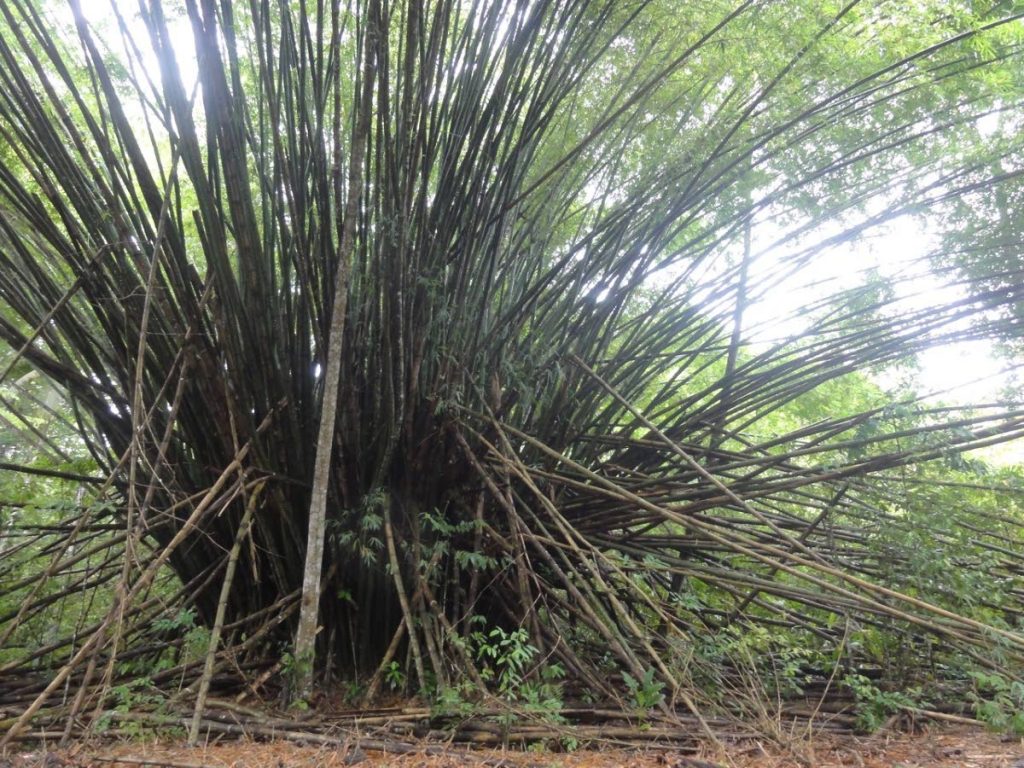The dark side of bamboo

Dr Anjani Ganase, marine ecologist, takes a look at the land and specifically one plant that can overgrow areas where forests are cleared. Alongside the cultural utility of bamboo, there is significant cost to the environment as bamboo spreads rapidly, edging out other plants and depleting the soil.
BAMBOO is the backdrop for picturesque scenes across our island landscapes. They create the settings of perfect postcard wedding photos; and they shape many scenes of Cazabon paintings. Bamboo is literally intertwined into our culture: essential for the celebrations of Divali, the stalks are stripped and shaped and displayed with deyas. Bamboo is also used to make furniture and jewellery.
Clumps of bamboo line many roadsides in north Trinidad, and can easily be spotted on the rolling hills of central and south Trinidad. In Tobago, bamboo may be less obvious, but take a closer look at the forests you pass along the Windward roads, you will see clumps of bamboo among the canopy of the forest.
The presence of large clumps of bamboo tells a story of forest degradation and transition. Bamboo plants naturally occur throughout the tropics and subtropics but a higher presence is often associated with human activities. As forests are cleared, for wood or agriculture, through slash and burn activities, the faster growing colonising vegetation will occupy the unused land. These fast colonisers are typically the grasses.

In TT, bamboo is a very common grass but it’s also one of the fastest growing grasses on earth. It can easily establish itself on any cleared landscape. Unlike other grass and weeds that may then be eventually dominated by other more aggressive plants and forest trees, bamboo has advantages in the air and under the earth. Its vertical growth and rhizome root system that can spread to large areas tend to prevent other trees or forest vegetation from re-acquiring space after bamboo sets in. As a result, the ecology of the area is permanently changed by bamboo.

Scientists have identified exactly how bamboo changes its surrounding habitat and the consequences of bamboo-invaded forests; and what it means for the integrity of the forest in the long-term. In general, bamboo is also considered hardy, where large well-established stand can be resistant to disturbance such as low-intensity forest fires or prolonged flooded conditions (Franklin et al 2009).
The bamboo clump forms a monoculture through the spread of the rhizomes in the top layer of the soil and is thought to directly dominate neighbouring tree seedlings. Scientists have also discovered that bamboo changes the soil conditions. As a grass, bamboo tends to suck the water from the soil, drying it out. Bamboo leaf litter and stems are naturally lower in nutrients, and high in lignin (good for building and furniture-making). Therefore bamboo leaf litter is harder to break down, and also poor in restoring organic matter and nutrients to the soil. The combination of the bamboo dominant leaf litter and the lack of other nutrient rich forest leaves around the monoculture stands may also limit the establishment of other tree seedling (Larpkern et al 2011).
Think about the ground underneath of bamboo patches, instead of rich soil there is a compact mat of bamboo leaf litter that doesn’t readily decompose. Large bamboo clumps may actually form canopies that may be suitable for shaded plants, but often the earth below would typically be bare. Consider that forests around the world are the major method of sequestering carbon since leaf litter is the biggest form of carbon sequestration on the planet. However, comparing the leaf litter of established forests to areas invaded and dominated by bamboo, the carbon storage capacity and nutrient quality of bamboo leaf litter is 50 per cent lower in the top soil (Zaninovich et al 2017). Clearly, allowing forest trees to be replaced by bamboo will dramatically reduce the carbon storage capacity in subtropical forests.
While certain areas in TT have been well established as bamboo forest, it is important to understand how human activities of land clearing leads to bamboo invasion and encroachment into forested areas, and the resulting forest degradation.
The Main Ridge Forest Reserve in Tobago has for centuries remained the most natural store of biodiversity, nutrients and the source and protection of our waterways. We need to actively continue to care about the quality of our forests – it’s not just bush. In Tobago, the Main Ridge is the second most important contributor to the air, water and health of this pleasant island paradise. The first, of course, is the ocean.
Earth Day Tip
Choose Matches Over a Lighter
As the majority of lighters these days are disposable lighters, 1.5 billion of them end up in landfills every year. They are also made of plastic and filled with butane, neither of which are environmentally friendly. Choose matches instead, ideally the paper ones. The wood ones are made from trees, but the paper ones are made from recycled paper so you are doing no harm.


Comments
"The dark side of bamboo"